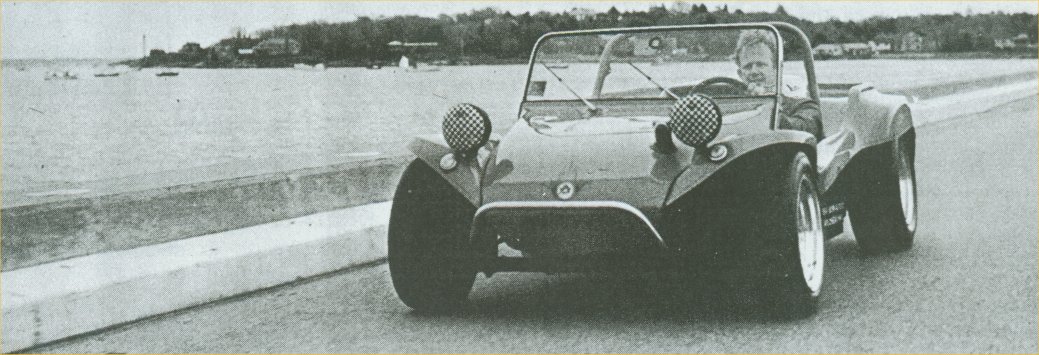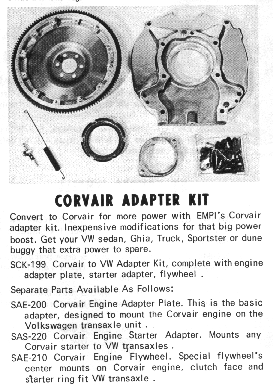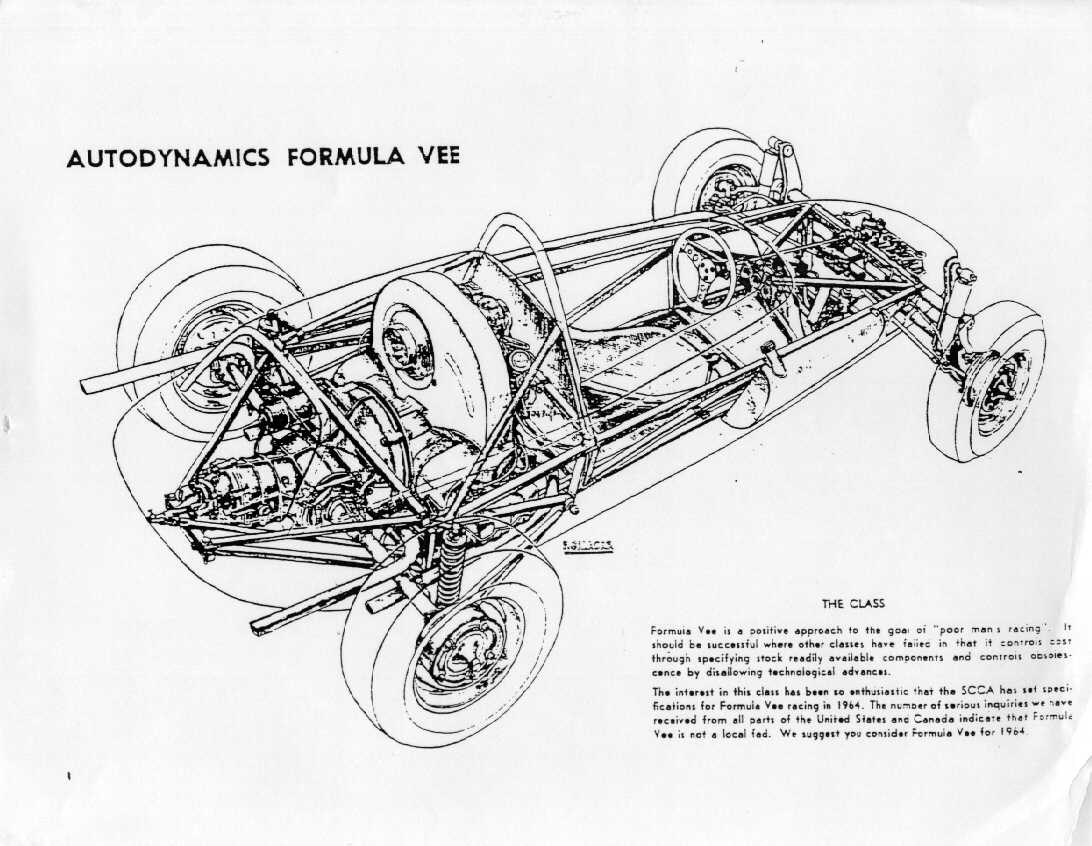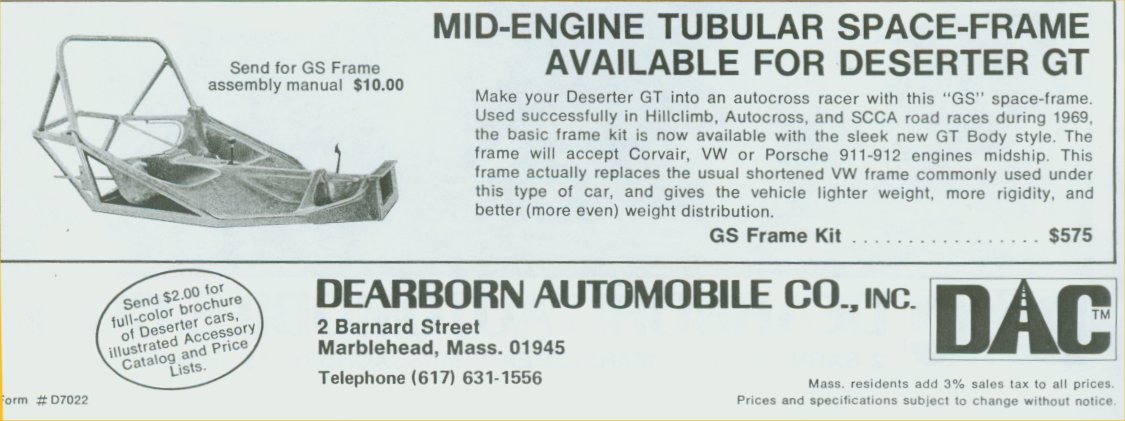|
The Deserter GS was a Poor man's Boxster, 30 years too early.

This is a site about the Autodynamics Deserter GS. The Deserter GS was an interesting combination of a
fiberglass dune buggy and a Formula Vee race car. Both were at their zeniths of popularity in the Late 1960s. The fiberglass dune buggy was an amazing phenomena where you took a wrecked or neglected VW beetle and combined it with a kit to make an open two seat roadster. This kit cost a few hundred dollars, and when combined with a few weekends of work, you had a real fun machine. Initially marketed at running the sand dunes of Southern California, Dune Buggy builders in other parts of the country used the vehicles for street use, going to school, or various other uses.

When you got your wrecked or neglected VW beetle, t
to make a Dune buggy, you first unbolted the body from the chassis of the car. You then cut 14" or so out of the wheelbase and bolted on a one piece fiberglass body. You then could reuse the VW seats, gauges, etc. Usually the stock VW engine, transmission and brakes were all retained from the VW. As thing went on, people wanted their Dune buggies to stand out from the crowd, and chrome wheels were added, dress-up parts, engine accessories etc. Eventually it was found that the engine from a Chevy Corvair could be mated to the VW transaxle and you could go from 36 to 140+ hp pretty easily. The Corvair engine only weighed 75 pounds more than the VW, and were plentiful in the wrecking yards, with over 1 million cars produced from 1960-1969.



The Formula Vee was designed as a very low cost racing series which used
a racing chassis which was combined with the mechanicals of a VW beetle 1200, including the engine and transmission. This series brought very competitive, wheel to wheel racing, for a relatively low price. The formula vees used a tubular steel chassis, covered in fiberglass body work, as was the style of formula cars at the time. This was about the cheapest way to racing at the time.

The formula vee used its engine in a MID engine layout, which was opposite of the VW beetle
with itís REAR engine layout. This gave better packaging and better distribution of weight in the car. Autodynamics had been successful making their Formula vees in the 60's and had decided to enter the dune buggy business. Their VW experience, combined with their fiberglass expertise made this a good proposition. Initially, Autodynamics created a traditional fiberglass dune buggy on a vw floor pan, but the influence of their Formula vee production gave owner Alex Dearborne an idea for a (at the time) radical hybrid. Autodynamics looked at their single seater formula vee chassis and designed a tubular frame chassis that retained the two seat configuration of the Dune Buggy and the Mid engine layout of the formula vee. They fitted late model VW beetle transmissions, brakes and axles and substituted a Corvair 2.7 liter 6 cylinder engines for the 1200 cc vw engine in the Formula vee. They sized this chassis so that their standard dune buggy body would fit the chassis, and created the Deserter GS. The chassis was very light, in line with current race car practice, and it used the fiberglass body to create a monoque to add to the strength of the car. A fiberglass interior floor pan was crated, with molded-in seats, placing the driver very low to the ground. Where a traditional dune buggy was jacked up with big tires to clear rocks and sand dunes, the GS sat low to the ground to help with handling. The car was designed for performance street driving, autocross, and road racing. With a weight of 1200 pounds and 110-180 hp the car was quite the performer. The rear suspension was pure formula vee with trailing arms and Koni shocks and the front had a better designed ball joint front end which allowed for fitment of disk brakes from the VW Karman Ghia. Wide wheels and tires completed the package and made a formidable little handler, which set Fast Time of the Day at many autocrosses. It fact a modified GS with a Porsche engine was a national autocross champ many years in a row in the late 70's. The GS also raced in professional and amateur road racing with limited success. Others were enjoyed as street toys. Less than 150 deserter GSes were built before the Autodynamics company went out of business after losing the Factory Dodge Trans Am contract. In fact, the GS molds and plans were lost for many years, long after the dune buggy explosion died in the 1970's. In 2002 the car is being resurrected in California and there are plans to reproduce these cars again. A small network of enthusiastic fans is still interested in restoring, modifying, and racing these cars, over 30 years later.

The GS was offered as a do-it-yourself kit, a complete car from the factory, or complete thru their network of dealers. In the 1970 season, Autodynamics switched from their original Dune buggy body, which was produced under license from Bruce Meyers, creator of the Meyers Manx, to a derivative of the Bounty Hunter body. The Bounty Hunter was another California design, a swoopy looking body that had much sports car influence. More and ĺ of the GS production used this body, with itís Renault Dauphine sourced windshield. It also allowed for a matching gull wing hardtop that added some protection form the elements. The engine in the GS was not always a Corvair, the fitment of VW or Porsche engines were allowed for in the design. With the stock horsepower advantage, and inexpensive Chevrolet pricing, the Corvair was the most popular choice.
^ back
to top ^
|